

Although it may not seem like it, what can broadly be termed "personal computing devices" are based on only three conceptual models. In order of their historical appearance, they are: the "stand alone computer model," which first came into being as the batch processing mainframe with a command line interpreter; the "networked stand alone computer model," which saw its first incarnation as the object-oriented workstation with a graphical user interface (GUI); and the "network interface computer model," a terminal-like computer for single users in an environment where all computers are linked together. The golden age of the first conceptual model has long passed, and the current age is a transitional period in which we are moving from the second conceptual model to the third.
What may be surprising to many is that the third conceptual model was first conceived not in the U.S., which has rightly earned the distinction of the "world's systems house," but rather in Japan, which has historically been viewed as a country that creates great hardware but is poor at software--particularly systems software. However, in the mid 1980s, long before computing platforms based on either the IBM-PC or Macintosh operating systems were considered for use as interfaces to a "network of networks" called the Internet, the TRON Project began work on the BTRON-specification operating system, which was conceived as a real-time human-machine interface to a "hypernetwork in which all computers and computerized devices throughout human society would be interconnected."
The network interface computer differs from the standard personal computers of today mainly in terms of size. Network interface computers have very small operating systems, and hence they require very little in the way of hardware resources to run. This allows them to be built at very low cost, which in turn allows organizations that employ them to save considerable amounts of money on management information systems. But all network interface computers are not based on the same design precepts.
One computing model for the network interface computer, the "network computer" proposed in the late 1990s in the U.S., was conceived of as a machine that would operate inside a company's local area network (LAN). Since it would always be used in conjunction with a company-owned server, programs and data could be stored there and downloaded as necessary. In fact, Sun Microsystems Inc., one of the companies that is strongly pushing for the adoption of network computers in the U.S., is planning to take this paradigm and apply it to the Internet. The company plans to offer its freeware StarOffice productivity suite via StarPortal, a Web site from which users can download data and applications and do data processing inside their browsers. People signing up for this service will only need a browser and an Internet connection. However, there is a problem with this computing model in that current browsers are huge applications, and they run on even larger operating systems, so the cost savings will mainly be limited to software. (For a critique of Sun's efforts with StarOffice, click here.)
That's where the BTRON-specification operating system is different. BTRON lies between today's gargantuan personal computer operating systems--which have become as large as mainframe computer operating systems and continue to get bigger with each new upgrade!--and the stripped down operating systems of LAN-based network computers. BTRON is compact, which is why basically the same BTRON3-specification source code can be used in both PDAs and IBM-PC/AT compatibles, and yet it is extremely powerful. The design specification calls for word processor and graphics editor functions as standard equipment, but the commercial implementation by Personal Media Corporation called B-right/V has, in addition, a spreadsheet program, a scripting language, an e-mailer, a card database program, a Web browser, PC communications software, plus various utilities, such as file converters--and that's not even to mention a World Wide Web-like hypertext filing system at the system level.
As a result, a BTRON-specification computer requires no Internet or LAN connection to do data processing, but the hardware required to run the latest BTRON implementation, B-right/V R2, is minimal: an Intel 486DX microprocessor-based PC, 16 megabytes of main memory, and a few hundred megabytes of hard disk space. In other words, a BTRON-based system can be manufactured almost as cheaply as a network computer, although it has all the functionality of a standard computer. And if that sounds too good to be true, it gets better. B-right/V R2 has for the first time in the history of personal computing implemented a true multilingual computing environment that allows users to employ up to approximately 130,000 characters in their documents. The majority of these characters are kanji (Chinese characters), which for the first time allow the Japanese people to write any word in their language--and they come in outline fonts to boot!
The BTRON3-specification "B-right/V" operating system for IBM-PC/AT compatibles was first marketed in Japan on July 18, 1998. Historically, B-right/V is a descendant of the "3B" operating system, which was designed for a TRONCHIP-based hardware platform called MCUBE that hit the Japanese market in 1995. The 3B operating system subsequently bifurcated into µBTRON-specification "B-right," which is used in Seiko Instruments Inc.'s BrainPad TiPO PDA, and B-right/V (B-right for DOS/V machines, which is what IBM-PC/AT compatibles are called in Japan). The code for both of these operating systems, which are based on a micro kernel design, is basically the same; there are only minor variations having to do with window functions, selectable colors, power saving, character input, etc., which are a result of the hardware limitations of handheld devices that do not use a keyboard.
There are, however, many differences between B-right/V and "B-right/V R2," the latter of which hit the Japanese market on November 12, 1999. The major difference is that B-right/V had only a partial implementation of the TRON Multilingual Environment. Specifically, its multilingual capabilities were based on a "single 48,400 character plane" (a plane is called a "script" in the TRON Architecture) into which multiple national character sets were loaded. The B-right/V R2 operating system, on the other hand, implements the true TRON Multilingual Environment, which is based on "multiple character planes of 48,400 characters" that can be switched in and out as required using "language specifier codes." [1] In fact, the current implementation has 31 such character planes defined for it, which means that it can handle a total of 1,500,400 characters. Needless to say, it is going to take some time to fill up that space.
The B-right/V R2 script planes and their current contents are as follows:
| System Script (0xFE21) |
|
| Japanese Script 1 (0xFE22) | Reserved |
| Japanese Script 2 (0xFE23) | Reserved |
| Chinese Script 1 (0xFE24) |
|
| Chinese Script 2 (0xFE25) | Same as above |
| Chinese Script 3 (0xFE26) | Traditional Chinese |
| Chinese Script 4 (0xFE27) | Same as above |
| Korean Script 1 (0xFE28) |
|
| Korean Script 2 (0xFE29) | Same as above |
| Various National Scripts (0xFE2a) |
|
| Mojikyo Script 1 (0xFE2b) | Konjaku Mojikyo characters |
| Mojikyo Script 2 (0xFE2c) | Same as the above |
| Mojikyo Script 3 (0xFE2d) | Same as the above |
| Mojikyo Script 4 (0xFE2e) | Same as the above |
| (0xFE2f - - 0xFE3F) | Reserved (17 planes) |
One thing that is important to note here is that there is no official "TRON Character Set." The BTRON operating system merely provides a "framework," called "TRON Code," into which character sets that have, or will, come into wide use are loaded. Of course, once those character sets are loaded into the TRON Code framework, a de facto "TRON character set" comes into existence as can be seen above, but there are no TRON Project committees deciding which characters can or should be used by BTRON end users. The TRON policy is to register all characters and leave it to the end user to decide which characters he or she should employ in data processing. In order to implement this policy, the TRON Project has also created a character registration center (officially called the "TRON Character Resource Center") on the Internet through which new characters can be added to the TRON character set. As long as the source of new characters is clear and there are no copyright complications involved, the character or characters will be registered free of charge and made available for downloading by BTRON user community.
Another thing that it is important to note--which no doubt is something that any Unicode folks reading this article would like to point out--is that the exact same Chinese character can appear on different planes in the TRON character set. That is absolutely correct, and it is in fact the reason that only a BTRON-specification computer can used used to discuss via e-mail the "unification" that the Unicode movement is undertaking, and it is why only a BTRON-specification computer can print out the entire Unicode specification. In other words, the lack of unification is not viewed as something bad, but rather as something that is good. There is, of course, the chance that the user will not be aware of what character plane he or she is dealing with. However, there are ways of checking. Hexadecimal savvy users merely have to check the language specifier codes given in the parentheses above, and ordinary users can pull a character into the Character Search Utility (see "New Utility for Searching for Kanji"below). Finally, since there are disagreements among specialists about what is and is not a "distinct Chinese character," a "thesaurus-like function" is also under development to give end users information to make their own judgments.
However, improvements to character-related functions in the B-right/V operating system that appeared with Release 2 are not limited to solely to the processing of kanji. As the following list of character-related improvements shows, proportional font compatibility and word wrap functions have been added. These functions are necessary for processing languages that are written with the Latin script. Moreover, there is also a multi-font function, which is necessary for doing high-quality word processing and desk-top publishing.
Among the kanji-related processing functions in the above list, the Character Search Utility, which will be described below, is essential to enable the end user to easily find his or her way through the large kanji character sets that come with B-right/V R2. But that utility is only necessary when the Japanese-language input system (kana-to-kanji conversion) does not output he desired characters. Thus it is important to note that the functionality of the Japanese-language input system has also been improved. The list display function makes it easier to select among the conversion candidates in input dictionaries, and the customization function makes it possible for the end user to match the input functions to his or her typing habits and even allocate key assignments.
TRON Project Leader Ken Sakamura has been saying for years that you can not just stuff a large number of kanji into a personal computer system and hope the end user will make good use of them. To use such a computer system, a function that makes it possible for the user to easily find the necessary characters is also required. Thus it is only natural that along with B-right/V R2's impressive unabridged kanji character set comes an extremely easy to use Character Search Utility that can--according to various specified search criteria--spit out huge lists of kanji in a flash. Perhaps the most remarkable thing about this utility is that it makes it possible to search for kanji without even knowing the "radicals" according to which the kanji are listed in traditional dictionaries. This is truly a revolutionary development for students beginning their study of Japanese.
As can be seen in Fig. 1, the Character Search Utility is a panel that fills a small section of the screen of a personal computer. The utility has three functions--the tabs at the top of the panel--that allow the user to select among: (1) viewing character codes, (2) searching for characters, and (3) looking up information about a character. In the example in Fig. 1, the Search function has been selected, and two radicals (basic elements used for sorting characters in traditional kanji dictionaries) have been input in the Search Key box. From left to right, these are kuchi hen ('mouth') and takumi hen ('carpenter's square'). Among the output characters, which cover two pages as indicated at the bottom of the panel, a character comprised of only these two radicals has been found on the Mojikyo Script 1 plane, and that character along with its character code has been displayed in the upper right hand corner for easy viewing. Please note that the output characters are color coded (black for JIS levels 1 and 2, blue for JIS auxiliary kanji, and green for non-JIS [Konjaku Mojikyo] characters), and that the "Enlarged Display" option has been selected in the lower left hand corner.
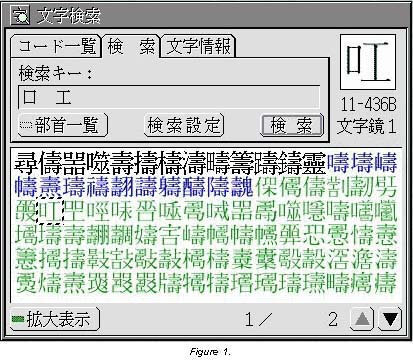
In addition to radicals, it is also possible to input the katakana pronunciations of the above radicals. Likewise, a character incorporating the same two elements can be used for searching for another character with the same two elements. Other search methods are based on arithmetic-like expressions. In Fig. 2, for example, the expression "too ('climb') minus mame hen ('bean') radical has been input, which yields the hatsugashira radical. In Fig. 3, the expression "kuchi hen ('mouth') times four" yields a huge list of characters, one of which on the Mojikyo Script 1 plane consists of exactly four mouth radicals.
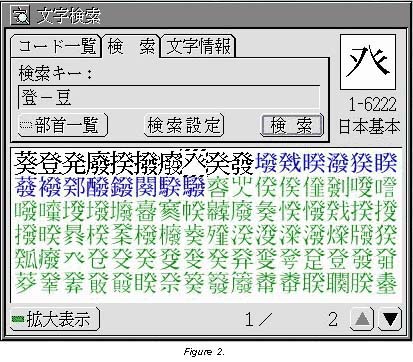 |
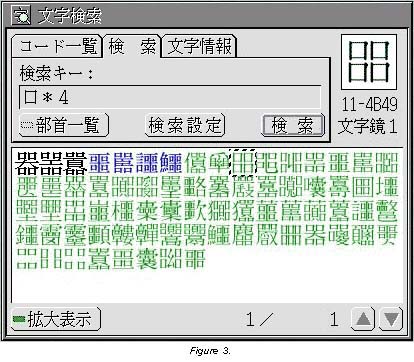 |
The Character Search Utility can also be used for obtaining information about a kanji that one does not know. In Fig. 4, the user has selected the Character Information function of the Character Search Utility and has dragged and dropped a character listed under the uo hen (the 'fish' radical) into it. The following information about the character, which is on the Mojikyo Script 2 plane, has been output:
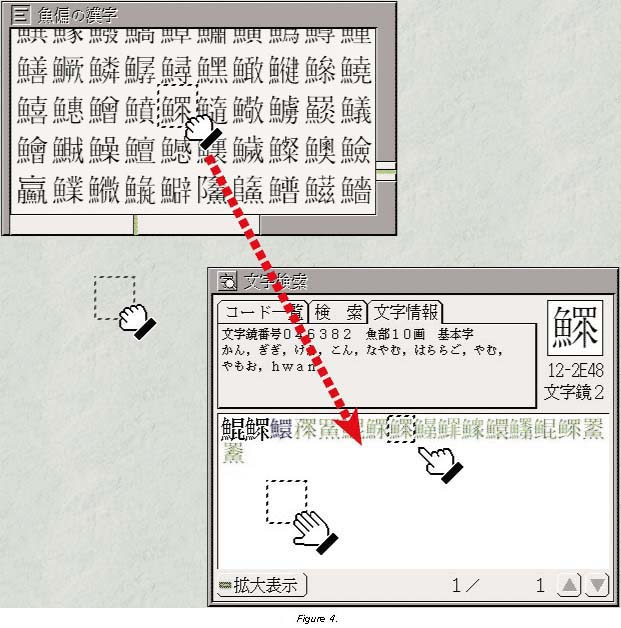
Conversely, by dragging and dropping kanji from the Character Information function of the Character Search Utility, the user can also easily create a custom kana-to-kanji conversion dictionary for converting Japanese syllabic data written with the hiragana syllabary in kanji. As is shown in Fig. 5, the user has entered two kanji and their readings (wanizame 'shark', and hararago 'hard roe') into a text real object (text file) titled "Uo Hen no Kanji Jisho ("Uo Hen Kanji Dictionary"). When the real object is closed (green dotted line) and the virtual object (link to that real object) is dragged and dropped into the User Dictionary registration panel (red dotted line), the user can then input the rare kanji using the operating system's kana-to-kanji conversion function.
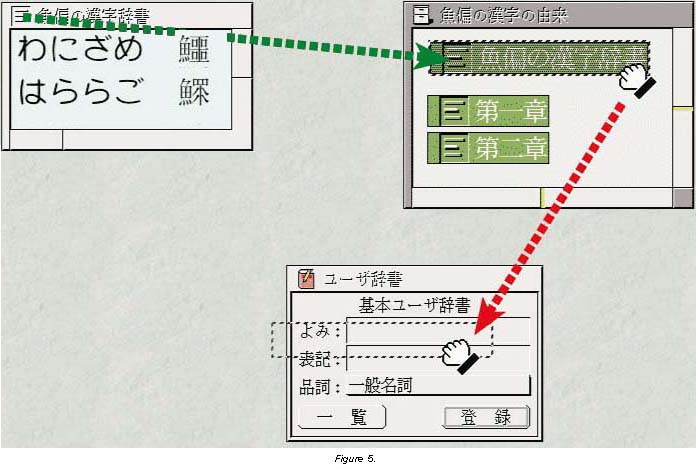
One thing that is not shown here--but which is exceedingly important to remember is possible!--is a user employing the Character Search Utility to read data from Web pages on the Internet. That is to say, critics of the TRON Project believe that an unabridged kanji character set is unnecessary, since no one knows as many as 80,000 kanji. Accordingly, not listing all of those kanji in a computer system only seems logical. However, if as shown above, a user can easily learn the pronunciations and readings of an unknown kanji simply by dragging and dropping it from a Web page into the Character Search Utility panel on the screen of his/her personal computer, then lack of knowledge tens of thousands of obscure kanji is no problem at all. This Character Search Utility can also serve as a dandy learning tool, both for native speakers of Japanese and foreigners studying the language.
As was stated in the first section of this article, the BTRON-specification computer was originally conceived as a real-time human-machine interface for a hypernetwork--specifically, the "TRON Hypernetwork"--in which every kind of computer device is linked together. Accordingly, networking functions are central to the BTRON computing model, and they are under constant development, both at Personal Media Corporation and at the Sakamura Laboratory on the University of Tokyo campus. The latest networking functions that have been added to the B-right/V R2 are as follows:
The PPP function allows BTRON users to connect to Internet service providers via dial-up (public telephone) lines using a modem. Since there are not many areas in which cable modem and/or Digital Subscriber Line (DSL) service is currently available in Japan, this is an extremely important function for people using BTRON from home. The e-mail software, which is freeware application developed at the Sakamura Laboratory, is a new type of e-mail application based on BTRON programming concepts. The application is made up of a group of miniature applications that are started up as necessary to handling outgoing and incoming e-mail.
The file transfer protocol (ftp) function is for the BTRON Basic Browser, which it enables to download download software from the Internet. The BTRON Basic Browser has been greatly improved compared to its first release. It is now possible to set fonts, and there are four Save options. The user can save a Web page as HTML, the Web page itself, or as a TAD (TRON Application Data-bus) text or graphic file, which are referred to as "real objects." When a Web page is saved as a TAD text real object, for example, the layout changes, but it is possible to click on a link and open up the Web page to see the latest update. This is an advanced feature that is not available to most people using a personal computer to surf the World Wide Web.
Supporting various types of peripheral equipment is the hallmark of a good operating system, and B-right/V R2 is squarely aimed at that target. The latest additions for peripheral equipment support are as follows:
For those who are unfamiliar with a "wheel mouse," it is in fact a PC mouse with a tiny wheel between the two keys that are respectively used for clicking and displaying pop-up menus. The wheel is used to scroll through pages, thus alleviating the need for the user to push page up/down keys, click scroll arrows, or drag scroll boxes.
The biggest problem that westerners have in evaluating Japan and/or Japanese technologies is that they believe what the U.S. is doing is the yardstick, and what Japan is doing should be evaluated according to that yardstick. Thus based on this "technocentric reasoning," if there is a higher penetration of personal computers in the U.S. than in Japan, then Japan is behind the U.S. in becoming "computerized." This reasoning, unfortunately, leaves aside the fact that millions of Japanese use "personal word processors," which are little more than specialized personal computers. Likewise, if several times more personal computer users access the Internet in the U.S. than in Japan, then Japan is behind the U.S. in "connectivity." This reasoning, unfortunately, leaves aside the fact that wireless usage in Japan--which is not to mention facsimile usage--is far higher than in the U.S. Moreover, this reasoning also leaves aside the fact that the overwhelming majority of the Web sites on the Internet have only English-language content!
Accordingly, when western analysts look at the BTRON subproject, they view it using the U.S. market as a yardstick. Since there are more application software programs that run on Microsoft Corporation's MS Windows or Apple Computer Inc.'s Macintosh operating systems than on B-right/V R2, then B-right/V R2 will go nowhere in the Japanese market. Unfortunately, that argument overlooks the fact that B-right/V R2 is all about bringing "new basic functions to the market," basic functions that neither Microsoft nor Apple are interested in providing to the Japanese people. BTRON3-specification B-right/V R2 is the first and only personal computer operating system that allows the Japanese people to write any word in their language. The Japanese people have only been able to do this on a personal computer since November 12, 1999--the day B-right/V R2 went on sale! Moreover, the BTRON3-specification operating system is the only operating system on the market that has a hypertext-like filing system. When this is improved to incorporate the HyperText Transfer Protocols of the Internet, it will be the only personal computer operating system to seamlessly integrate a personal computer filing system and the structure of the World Wide Web.
And so, this is where the immediate future of the B-right/V R2 operating system lies--in bringing new basic functions to the market and consistently improving upon them. One of the first improvements to the B-right/V R2 operating system will have to do with the TRON Multilingual Environment, which in the present implementation only realizes two layers (Font and Script) of the four-layer hierarchy (Font, Script, Group, and Language). Thus one of the coming improvements to the B-right/V R2 operating system will be the expansion of the language specifier codes to include the Group and Language layers. In addition, other key parts of the multilingual environment, such as algorithms for expressing the various languages in writing, will have to be developed. One important element of this work will be expanding the functionality of the Basic Text Editor, which currently only accepts left-to-right horizontal character input. In the future, it will have to accept both vertically written (top-to-bottom) input and right-to-left horizontal character input. In addition, various sorting algorithms, such those for putting word lists in alphabetical order, will have to be developed to deal with input data in various national languages.
There is, however, one U.S. market yardstick that the BTRON-specification operating system should be measured against. That yardstick is following through on what one has promised to end users. If one promises end users something and then does not follow through on that promise, that party is guilty of producing what is known as "vaporware," software that's all talk and no reality. Well, the TRON Project promised the world the best multilingual operating system on the planet back in 1987 at the Second TRON Project Symposium, and 12 years later it came through on that promise when it unveiled the B-right/V R2 operating system. And so if anyone wants to know where the BTRON3-specification B-right/V R2 operating system is headed, the answer is "exactly where its developers say it's headed." So stay tuned for some extraordinary developments in the world of personal computing that are going to take place on top of this unique and highly flexible operating system. The BTRON subarchitecture has only just started to show its greatness.
Although not many third party commercial software applications exist for the B-right/V R2 operating system at present, there is a considerable number of freeware/shareware programs available for downloading from the Internet. A large list of these, the majority of which are freeware, is maintained at the following URL.
http://www.top.or.jp/~jnetwork/BTRON/BtronSoft.htm
As of this writing, 64 entries are listed there, including the B-right/V R2 development environment from Personal Media Corporation. Since they are described in Japanese, let me give the categories and number of programs below.
B-right/V R2 users should continually check this Web page, since new entries are constantly added.
There is also a list of B-right/V R2 freeware that is maintained at the Yahoo! Japan Web site. The URL is:
http://download.yahoo.co.jp/vector/other/tron/